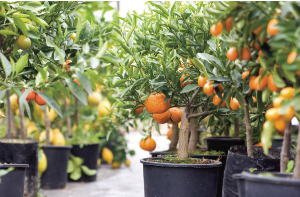
To choose the best tree suited for your location, consider the type of soil where you will plant your tree; overhead obstructions such as electrical wires; environmental conditions, including high winds or salt air; and what you want your tree to look like when mature. Trees that grow too large for their location can cause sidewalk damage. Roots can also grow deep into the ground and into underground water pipes through seams.
A newly planted tree requires at least 15 gallons of water per week and should have proper support until it is strong enough to stand on its own. Arbor stakes can be used to create a frame and tied with string or arbor ties to the tree. Keep the ties loose to ensure that the tree can grow on its own.
Enjoy your own Meyer lemons, kaffir limes and Trovita oranges
Dwarf citrus trees are ideal for the City, and whether planted in the ground or in a container, they can add beauty, fragrance and function to a landscape. The dwarf quality is achieved by grafting orchard-proven cultivars onto dwarf rootstock. Although dwarf citrus do well planted directly in the ground, they are also commonly planted in ornamental containers or wine barrel planters. They can grow to eight feet in the ground, but will stay much smaller if container-planted.
Good drainage is essential. If you are planting in the ground, plant the tree in a mound somewhat above grade, and make a water well with a ring of soil about a foot from the stem. The top of the root ball can remain slightly exposed. If you will be planting in a container, make sure it is at least 16 to 20 inches in diameter.
Watering is key to the growth of your citrus tree. Do not let your tree dry out completely. Watering twice a week may be sufficient, but gauge your watering schedule according to the weather, season and the microclimate of your particular location. Newly planted trees need more frequent watering until they are established. If new growth wilts or leaves are dull, you are waiting too long to water.
Citrus trees are heavy feeders and should be fertilized regularly. If your plant has yellowing leaves, it’s usually a lack of fertilizer or poor drainage. To thrive, a dwarf citrus need lots of light, heat and plenty of water. The ideal planting location is next to a reflective wall with southern exposure. Do the best you can to satisfy this condition, but don’t worry – dwarf varieties can do extremely well in San Francisco’s microclimates.
See you around the house and garden!
Julia Strzesieski is the marketing coordinator at Cole Hardware and can be reached at julia@northsidesf.com.








